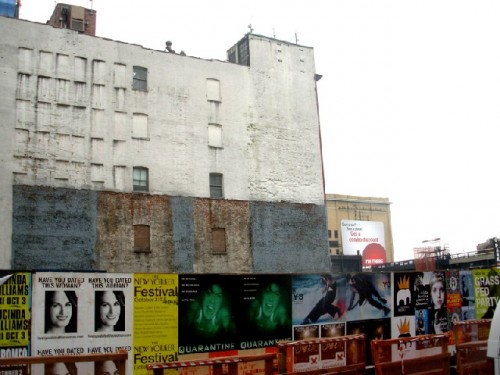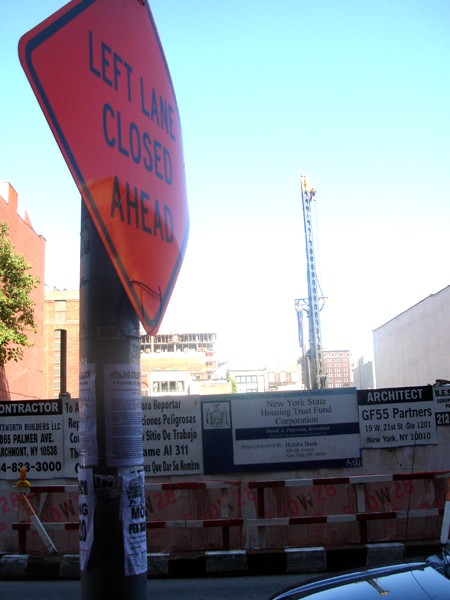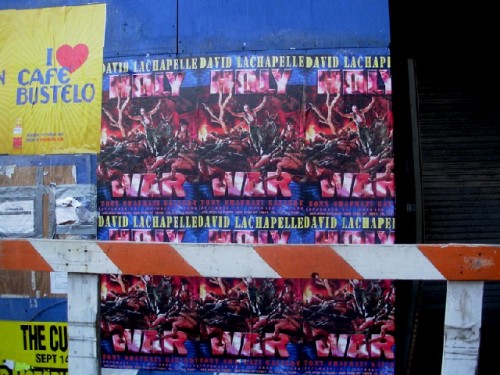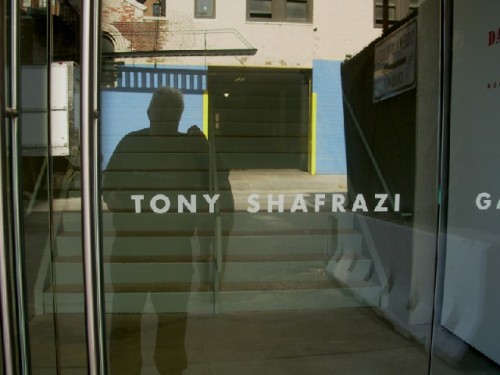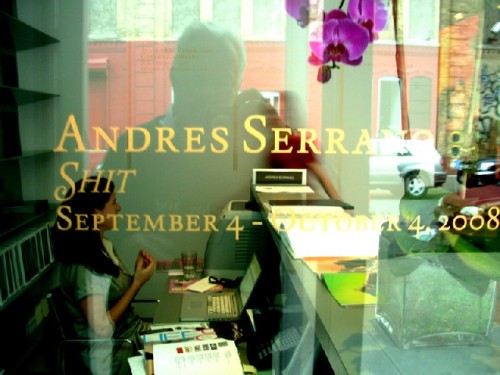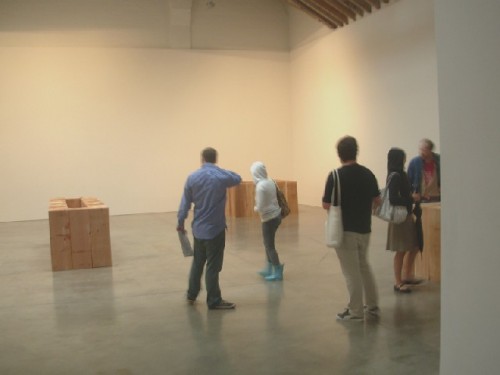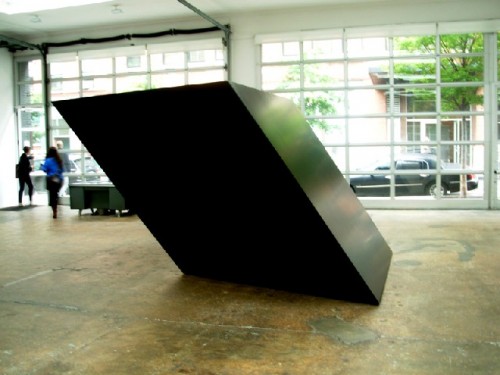The Big Bad Bear Prowls in Chelsea
Tough Times for the Global Art Market
By: Charles Giuliano - Oct 11, 2008
During a tour of Boston galleries at the end of the Spring season we found significant change. Several dealers on Newbury Street and in the South End were packing up rather than signing a new round of five year leases. Some, expressing concerns but seeing no real alternative, were making renewal commitments or relocating. One widely respected gallerist known for developing emerging artists stated that she would have liked to hang on but her business partner did not wish to continue.
Viewing these changes as significant we reported on them. When I asked an editor for a regional art publication if they planned to cover these changes the response was apathetic. Or, as a long established Newbury Street dealer put it "The tide comes in the tide goes out." Link to Downsizing Boston Galleries
As events of the past weeks have demonstrated there is a difference between the ebb and flow of tides, the natural rhythm of the always fluctuating art market, and a Tsunami. Right now the catastrophic, once in a lfetime, financial impact on the art market is not A story but The story.
During a recent visit to Chelsea the Saturday afternoon traffic seemed unusually sluggish. In the high rise art buildings of New York's primary gallery district there were just a handful of visitors. Even the major spaces of the leading, world renowned galleries were sparsely populated. We were virtually alone while visiting Aquavella, a blue chip dealer, steps from the Metropolitan Museum of Art, in the posh tenderloin of the Upper East Side.
If traffic and sales were off in late September, when the art world normally launches the fall season, then what to say, today, when the Global economy is plunging into a decline it has not seen since the Great Depression? A couple of weeks ago Chelsea dealers we talked with were wondering how long they would hold on now that cutbacks of incredible dimension seem absolutely inevitable. There were stories of not making any sales since late May. Shows of new work by emerging and mid level artists that would normally draw traffic and sales were running flat.
The October issue of Art Forum Magazine is 416 pages, plus cover. Much of this telephone book sized publication is filled with full page advertisements for a global art market that has expanded beyond all reason. In addition to maintaining enormous spaces, some of which have the dimensions, staff, and operating expenses of small museums, there is also the rat race of keeping pace with the many international art fairs. Even small spaces in the lesser fairs cost some $20,000 each to participate.
There are many fingers to point and enough blame to go around. The very fact of the greatly expanded art world in recent years has ironically morphed being an artist from an avocation to a profession. Earning an M.F.A. from a major program, in general a growth industry, is perceived as just as viable an option as an M.D., Ph.D., or M.B.A. Parents on the beach in the Hamptons brag that their kids get into RISD, Pratt, or Yale. When I told my father that I wanted to be an artist he tried, literally, to beat some sense into me. Today, Dad would insist that I get an M.F.A. and quit if, after five years, I did not get into the Whitney Biennial.
The sweet spot for emerging artists is viewed as the first five years after graduation. Those who do not prove themselves during that window of time and opportunity are generally abandoned in favor of the next crop of newly minted artists. In recent years academic programs have churned out a conveyor belt of twenty something talent.
Actually, today an M.F.A. is no longer that safety net, terminal degree that secures a tenure track position in a college or university. Purely through excess and greed there is a move in the academic game to up the stakes requiring studio artists to pursue the ersatz, bogus, terminal degree of Doctor of Fine Arts. It is just a scam to keep artists in the academy paying tuition a couple of years longer. It is alleged to put studio artists on the same level with other professors where the norm is a Ph.D. It will also qualify artists holding Doctorates more commonly to serve as deans and directors of art colleges.The acaedemy is less inclined to develop and nurture talent than a hungry beast intent on feeding and sustaining itself. How best to sustain that glut of professors many of whom maintain professional activity only to satisfiy requirements for tenure and review.
Does that mean that the academy is churning out better artists? While more intensive training and increased qualifications mean that artists are languishing longer in the academy just what is the end result? It seems that we have produced a generation of young artists ever more conversant with art speak, the theory driven, lingua franca of the art world. This has created a glut of newly graduated creators, with staggering loans to pay back, producing work that is smart and sophisticated but too often devoid of depth, experience and soul. Why do I so often leave a day spent in Chelsea feeling so blah and enervated? With the exception of a handful of shows by established artists in blue chip venues.
The staggering and unreasonable growth and expansion of the art world has been fueled by a feeding frenzy of greed and opportunism that has little to do with the basic issues of aesthetics. All of those newly minted artists get sorted out by an expanded network of dealers. Many of these gallerists are young and similarly educated as the artists they represent. Often these new dealers have emerged from the numerous arts administration programs and may have then interned for a couple of years at a major gallery.
Long established dealers whom we spoke with described a familiar pattern. They take on emerging artists then after several shows, and a few years, manage to increase their prices from $2,000 to $4,000 per work to a range of $20, 0000 to $40,000. At which point the artists often defect to the next tier of galleries. "What about contracts?" I asked somewhat naively. The response was ironic laughter. Just who has the resources to fight expensive legal battles with dealers having deeper pockets. Threats, raids, defections, and law suits, at every level, are the norm of the art world. Arguably, it has always been like that but is more visible now because of the vastly increased dimension of the art world. Instead of Art Forum, and its heady discussion of aesthetics, what the art world needs is more business analysis. Tip sheets for dealers and collectors. What to buy, hold, or trade. Some way of handicapping artists like race horses.
What happens when more top level artists like Damien Hirst cut out the dealers, and their usual 50% commissions, and go straight from the studio to the auction block? This is introducing another fear factor for major dealers. But also more and more reducing art to just another commodity. Investors can trade in Hirst more or less as they buy and sell pork bellies. Just how can one continue to respect a Damien Hirst? Is he an artist or a con artist? Where is the integrity in cranking out product?
There is the interesting wild card of real estate. In the beginning the development of Chelsea, and the slow migration from Soho, was about creating an affordable gallery district. Big spaces and cheap rents were the initial lure in Chelsea. As it had been in Soho. In our visits, staggered by intervals of time, we were always surprised as Chelsea expanded. Eventually, there was enough critical mass that, when visiting New York, we could skip Soho with impunity.
In the past couple of years there has been another trend. We have seen more and more, high rise condo buildings in Chelsea. No matter how expensive they seem to sell out quickly. As leases expire there is a squeeze on galleries to pay inflated rents or pay as much a million or two for a modest space. Right now, not many mid level galleries are making that kind of money. And galleries with deeper resources, who bought those former garages, are tempted to cash out. It may be worth a lot more to develop those ground level garages as high rises than to continue as gallery venues. Or, to revert back to a garage on the ground level, with a gallery above, and condos above that. This development boom, factoring in the currency freeze, will dramatically transform Chelsea as a gallery district over the next few years.
Although Brooklyn has declined as an option for emerging galleries there is a trend to reconsider the Lower East Side. It is significant that the New Museum moved from moribund Soho a relatively short distance to the Bowery. There is more development on the bookends of Chelsea. Next stop Harlem? Or New Jersey?
Even though the market turmoil is giving us agita and sleepless nights, hey, we are all in this together. If you or I go down the world goes with us. There is another side to this that says change is good. Indeed, the tide does come in and goes out. Hard times have a way of forcing us to look at priorities and values. It is entirely possible that a tougher and contracted art world will result in work that has more focus and conviction. You have to suffer if you want to sing the blues.
And what will happen to that latest crop of M.F.A.' s when the booming art world they were expected to emerge into no longer exists? Perhaps, like the Left Bank existentialists of Post War Paris, they will meet over lattes at Starbucks and debate theories they learned in art school. Or get a job.


